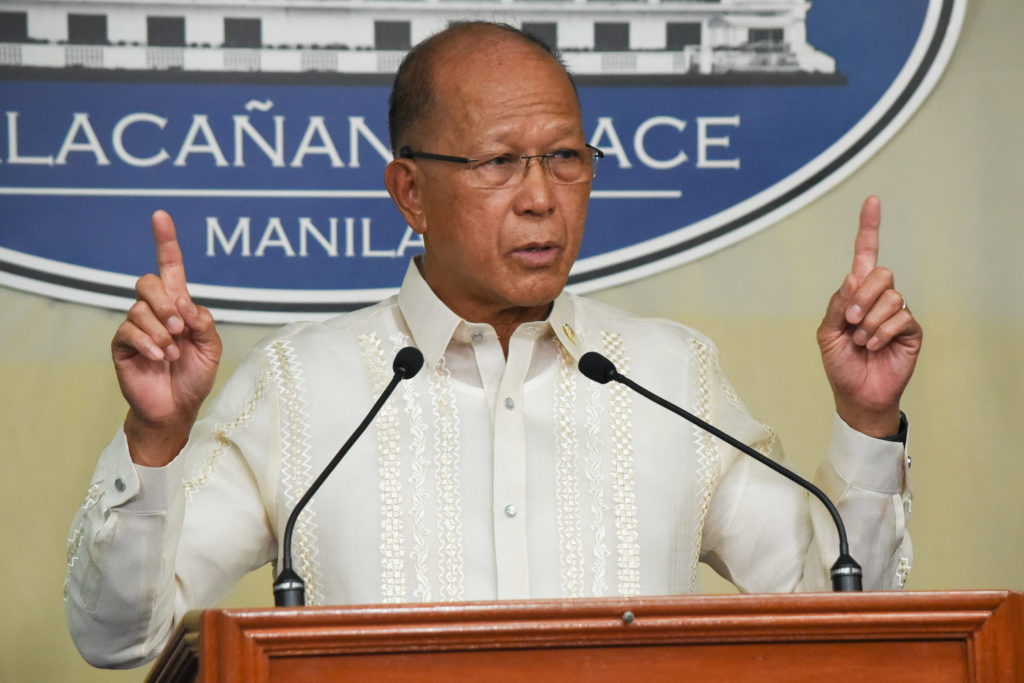
Defense Secretary Delfin Lorenzana PRESIDENTIAL PHOTO
President Rodrigo Duterte stopped the building of nipa huts and other construction work on a newly formed sandbar in the disputed South China Sea after China protested, Defense Secretary Delfin Lorenzana said on Wednesday, disclosing details of the new territorial spat for the first time.
The dispute over a string of sandbars called Sandy Cay emerged in August and prompted China and the Philippines to consider negotiating some sort of protocol or arrangement to allow both sides to prevent such incidents from spiraling out of control, Lorenzana said.
The rift over the tiny sandbar near the Philippine-occupied Pag-asa Island — internationally known as Thitu Island — in the Spratly archipelago remains unresolved but both sides pledged not to occupy any new territory, he said.
Overlapping claims
China’s claims to most of the South China Sea overlap with those by the Philippines, Brunei, Malaysia, Vietnam and Taiwan.
Despite that, tensions have eased since Mr. Duterte took over as President last year and took steps to thaw once-frosty relations with China.
Mr. Duterte has courted Chinese trade and assistance and taken a nonconfrontational approach to their territorial disputes.
He has refused to immediately take up with China a ruling by the UN-backed Permanent Court of Arbitration in The Hague that invalidated Beijing’s sprawling claims in the South China Sea, sparking criticism from nationalists and left-wing groups that wanted him to demand Chinese compliance with the landmark decision immediately.
On Wednesday, however, he said he planned to raise the issue of conflicting claims in the South China Sea at the Asia-Pacific Economic Cooperation (Apec) Summit in Vietnam, and ask China its real intentions.
Speaking to reporters before departing for Vietnam to attend the summit, Mr. Duterte said he would ask Chinese President Xi Jinping, who would also attend the meeting, if Southeast Asian countries were allowed to freely navigate the South China Sea.
“Not because I’m so much interested as a person but for the sake of my country and the others who have the overlapping claims,” he added.
‘Let’s pull out’
Lorenzana said Marines were sent to Sandy Cay to build nipa huts — shelter made of bamboo and palm roofing — for Filipino families and fishermen.
There were also Chinese fishermen on the sandbar, about 500 square meters large, he said.
“China complained because the Philippines was occupying new features, which it said was a violation of a bilateral agreement,” Lorenzana told a diplomatic forum, adding that Mr. Duterte later ordered, “Let’s pull out.”
“We pulled out and no structures were built there but both sides agreed there would be no new occupation,” he said.
Mr. Duterte made the decision after Foreign Secretary Alan Peter Cayetano advised him of an agreement involving China and the Philippines for a halt on new construction in the disputed waters, Lorenzana later told a news conference.
The Philippines has pressed ahead with $25 million of upgrades to Pag-asa Island, the largest of five islands the country occupies in the Spratly chain.
A small community of Filipinos has lived there since the 1970s, although conditions are basic compared to those enjoyed by Vietnamese and Chinese on other islands in the archipelago.
Philippine foreign affairs and military officials refused to divulge details of the dispute at Sandy Cay in August.
Chinese watch
Two senior Philippine security officials told The Associated Press (AP) at the time that three Chinese Navy ships, a Coast Guard vessel and 10 fishing boats began keeping watch on Sandy Cay after spotting the Filipinos on the barren sandbar.
Sandy Cay is located 4.6 kilometers from Pag-asa Island, which is known to the Chinese as Zhongye Dao.
On Aug. 15, a blue Chinese helicopter flew low off Pag-asa’s southwest coast, a security report seen by AP said.
The Chinese military presence off Sandy Cay sparked concerns in Manila.
Supreme Court Senior Associate Justice Antonio Carpio, who has studied the disputes extensively, said then that the Chinese Navy ships and other vessels encroached on the Philippine island’s 22-kilometer territorial waters. —Leila B. Salaverria and the wires

